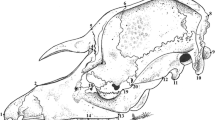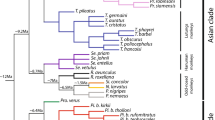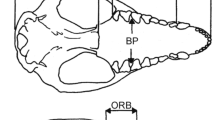Abstract
Examinations of 23 forms ofCallicebus were made to elucidate their phylogenetic relationships based on cranial measurements. Multivariate statistical methods of distance analysis utilizing Q-mode correlation coefficients and principal component analysis were employed. As a result, the following five distinct groups were recognized morphometrically among the 23 species and subspecies: theDonacophilus, Cupreus, Moloch, Personatus, andTorquatus groups. Moreover, the phenetic characters of cranial size, karyotype, pelage coloration, and geographic range were consistent with the results of this group classification. It could be safely concluded therefore that these groups represented phylogenetically independent groups, in view of the fact that the rate of character differentiation was not appreciably different among closely related groups. Of the five groups, thePersonatus andTorquatus groups were respectively considered to maintain a higher peculiarity of character differentiation within theCallicebus phylogeny, since these two groups individually displayed the higher magnitudes of differentiation in both their craniometric shape and some phenetic features. Conversely, the other three groups were considered to be closer to each other in theCallicebus phylogeny.
Similar content being viewed by others
References
Albrecht, G. H., 1978. The craniofacial morphology of the Sulawesi macaques: multivariate approaches to biological problems. In:Contributions to Primatology, Vol. 13,F. S. Szalay (ed.), S. Karger, New York, pp. 1–121.
Corruccini, R. S., 1973. Size and shape in similarity coefficients based on metric characters.Amer. J. Phys. Anthropol., 38: 743–753.
de Boer, L. E. M., 1974. Cytotaxonomy of the Platyrrhini (primates).Genen Phaenen, 17(1–2): 1–115.
Egozcue, J., E. M. Perkins, F. Hagemenas, &D. M. Ford, 1969. The chromosomes of some Platyrrhini (Callicebus, Ateles, andSaimiri).Folia Primatol., 11: 17–27.
Ford, S. M., 1980. Phylogenetic relationships of the Platyrrhini: the evidence of the femur. In:Evolutionary Biology of the New World Monkeys and Continental Drift,R. L. Ciochon &A. B. Chiarelli (eds.), Plenum Press, New York, pp. 317–330.
Hershkovitz, P., 1963. A systematic and zoogeographic account of the monkeys of the genusCallicebus (Cebidae) of the Amazonas and Orinoco River basins.Mammalia, 27(1): 1–80.
————, 1988. Origin, speciation, and distribution of South American Titi monkeys, genusCallicebus (family Cebidae, Platyrrhini).Proc. Acad. Nat. Sci. Philadelph., 140(1): 240–272.
----, 1990. Titis, New World monkeys of the genusCallicebus (Cebidae, Platyrrhini): A Preliminary Taxonomic Review.Fieldiana, Zool. New Series, Field Museum of Natural History, Chicago, pp. 1–109.
Ichihara, K., 1990.Statistics for Bioscience. Nanedo, Tokyo. (in Japanese)
Kinzey, W. G., 1981. The Titi monkeys, genusCallicebus. In:Ecology and Behavior of Neotropical Primates, Vol. 1,A. F. Coimbra-Filho &R. A. Mittermeier (eds.), Academia Brasileira de Ciencias, Rio de Janeiro, pp. 241–276.
———— &A. H. Gentry, 1979. Habitat utilization in two species ofCallicebus. In:Primate Ecology: Problem Oriented Field Studies,R. W. Sussman (ed.), John Wiley & Sons, New York, pp. 89–100.
Kobayashi, S., 1990. A morphological study of upper first and second molars in the genusCallicebus.J. Anthrop. Soc. Nippon, 98(2): 121–135.
————, 1991. A cranial size difference in the genusCallicebus. In:Primatology Today, Proceedings of the XIIIth Congress of the International Primatological Society,A. Ehara,T. Kimura,O. Takenaka, &M. Iwamoto (eds.), Elsevier, Amsterdam, pp. 535–536.
Martin, R. &K. Saller, 1957.Lehrbuch der Anthropologie, Vol. 1. Gustav Fischer Verlag, Stuttgart.
Minezawa, M., O. C. Jordan C., &C. J. Valdivia B., 1989. Karyotypic study of Titi monkeys,Callicebus moloch brunneus.Primates, 30: 81–88.
Natori, M. &T. Hanihara, 1988. An analysis of interspecific relationships ofSaguinus based on cranial measurements.Primates, 29: 255–262.
Pieczarka, J. C. &C. Y. Nagamachi, 1988. The karyotype ofCallicebus moloch moloch (Cebidae, Primates).Rev. Brasil. Genet., 11(3): 653–659.
Prance, G. T., 1982. Forest refuges: evidence from woody angiosperms. In:Biological Diversification in the Tropics,G. T. Prance (ed.), Columbia Univ. Press, New York, pp. 3–24.
Rohlf, F. J. &R. R. Sokal, 1965. Coefficients of correlation and distance in numerical taxonomy.Univ. Kansas Sci. Bull., 45: 109–126.
Sneath, P. H. A. &R. R. Sokal, 1973.Numerical Taxonomy: The Principles and Practice of Numerical Classification. Freeman, San Francisco.
Suzuki, T., 1977.Jintai Keisoku. Ningen to Gijyutsusha, Tokyo. (in Japanese)
Author information
Authors and Affiliations
About this article
Cite this article
Kobayashi, S. A phylogenetic study of titi monkeys, genusCallicebus, based on cranial measurements: I. Phyletic groups ofCallicebus . Primates 36, 101–120 (1995). https://doi.org/10.1007/BF02381918
Received:
Accepted:
Issue Date:
DOI: https://doi.org/10.1007/BF02381918




